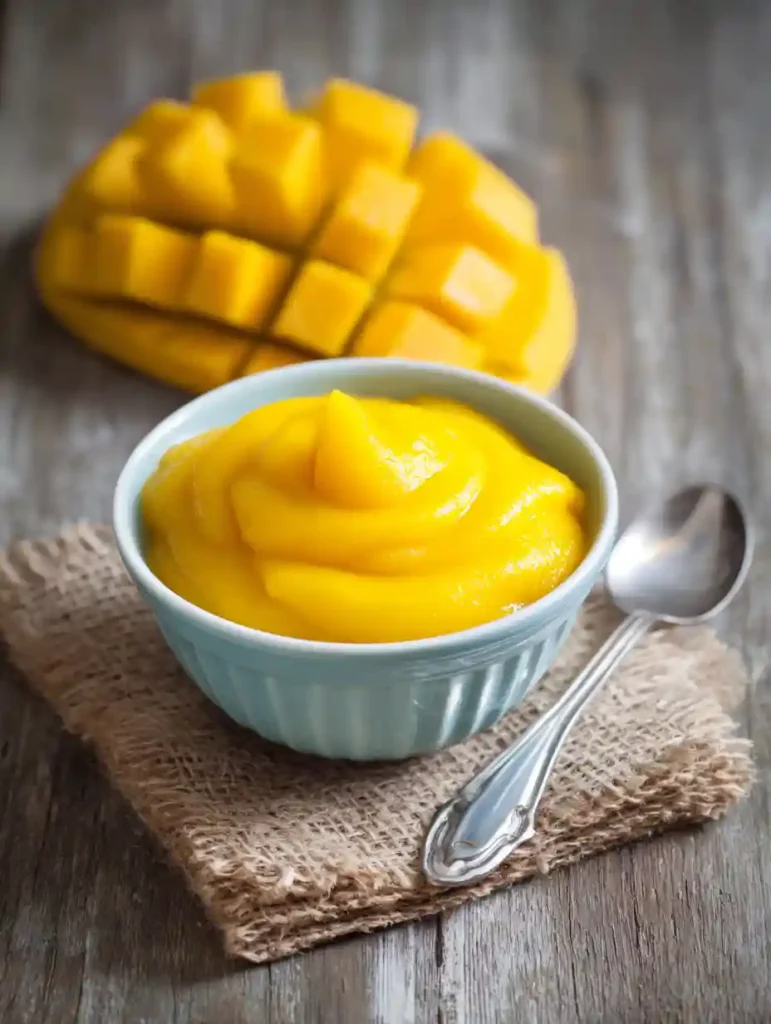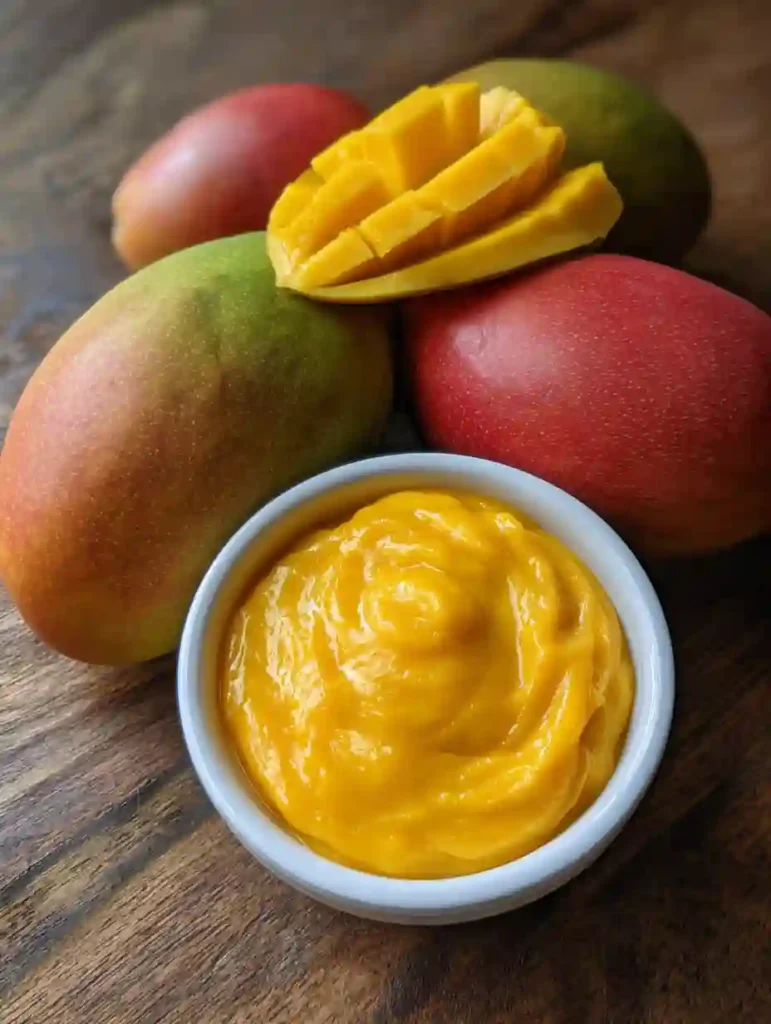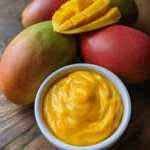Mango puree isn’t just a tropical treat—it’s a versatile, vibrant, and surprisingly powerful ingredient that’s taken over kitchens for good reason. Whether you’re whipping up baby food, blending refreshing drinks, or looking for a natural sweetener for your desserts, this recipe offers endless possibilities. But here’s the thing: not all mango purees are created equal.
What if you could master the art of making smooth, naturally sweet mango puree at home in just minutes? What if you knew exactly how to store it, use it in drinks or meals, and even make it baby-safe?
In this complete guide, we’re going deep into everything mango puree. You’ll learn the best mangoes to use, step-by-step recipes, smart storage hacks, its surprising health benefits, and why it’s one of the best fruit purees for babies. You’ll even find answers to the most searched questions like “Is mango puree good for babies?” and “Will mango puree help baby poop?”

So if you’ve ever wondered how to make mango puree that’s just as good (if not better) than store-bought, or if you’re looking to use it beyond just smoothies, you’re in the right place. Let’s get started.
Table of Contents
Table of Contents
And this is just the start. In the next section, we’ll dive into the exact ingredients and tools you need to make a flawless mango puree at home—without any guesswork.
PrintSimple Mango Puree – The Easiest Way to Make It at Home
📝 Description:
This homemade mango puree is smooth, sweet, and bursting with tropical flavor. Perfect for baby food, drinks, desserts, or sauces—made with just fresh mango and optional add-ins for taste and texture.
- Prep Time: 5 MN
- Cook Time: 00 mn
- Total Time: 05 mn
- Yield: 2 pers 1x
Ingredients
🧪 Ingredients:
2 cups ripe mango chunks (fresh or frozen, thawed)
1–2 tbsp water or lemon juice (optional, for easier blending)
Optional: 1–2 tsp maple syrup or honey (for adults only)
Instructions
🥣 Instructions:
Prep the mango: Peel, pit, and chop fresh mangoes into chunks. If using frozen mango, thaw completely before blending.
Blend: Add the mango chunks to a blender or food processor.
Add liquid if needed: For smoother texture or to assist blending, add a splash of water or lemon juice.
Optional sweetener: Add maple syrup or honey for flavor (only if not serving to babies under 1).
Blend until smooth: Process for 30–60 seconds until the puree is creamy and lump-free.
Use or store: Serve immediately or store in an airtight container in the fridge for up to 3 days, or freeze in ice cube trays for later use.
Notes
For baby food, skip sweeteners entirely.
Lemon juice helps preserve color and adds a mild tang, especially when used in drinks.
Freeze leftover puree in ice cube trays for portion-controlled use later.
Nutrition
- Serving Size: 2 (makes about 1½ cups)
Mango Puree Recipe: Ingredients and Tools You Need
Making homemade mango puree is incredibly easy and doesn’t require much. Whether you’re preparing it for babies, drinks, or desserts, the process is the same—just real fruit and a few kitchen basics.
Ingredients
To prepare fresh, smooth mango puree, you’ll need:
- 2 cups of ripe mango chunks (fresh or frozen, thawed)
- A splash of water or lemon juice (optional, to help blending)
- Optional: maple syrup or honey (only for adults, not for babies under 1)
That’s it—no additives, no processed ingredients. Just pure, natural fruit.
Tools You’ll Need
- Blender or food processor
- Spatula (for scraping the sides)
- Fine mesh strainer (optional, for extra smooth baby food)
- Storage containers or ice cube tray (for freezing)
A high-speed blender will give you the best, smoothest texture. A food processor also works well but may need a bit more time.
How to Make Mango Puree
- Add mango chunks to your blender or food processor.
If you’re using frozen mangoes, make sure they are fully thawed. Don’t discard the juice—it adds sweetness. - Blend until smooth.
Start blending and pause if needed to scrape down the sides. If the mangoes are too firm or dry, add a splash of water or lemon juice to help the blending process. - Taste and adjust if needed.
If your mangoes aren’t sweet enough, feel free to mix in a small amount of maple syrup or honey. Just remember—do not use honey if you’re making mango puree for babies under one year old. - Use or store.
You can use the mango puree right away, or store it in an airtight container in the fridge for up to three days. For longer storage, pour the puree into an ice cube tray, freeze it, and transfer the cubes to a freezer-safe bag. Frozen mango puree will last up to six months.
This mango puree recipe is perfect for smoothies, baby food, desserts, and even savory dishes. It’s fast, healthy, and incredibly versatile. Now that you know what goes into it and how simple the process is, we’ll move on to mastering the step-by-step method in the next part.

How to Make Mango Puree at Home
Making mango puree at home takes less than five minutes, and the results are often better than anything store-bought. You get complete control over the flavor, texture, and freshness—with no added sugar or preservatives.
Here’s your simple, go-to method for a smooth and vibrant mango puree recipe that works for babies, drinks, desserts, and more.
Step 1: Choose Your Mangoes
Start with ripe, sweet mangoes. If you’re using fresh ones, make sure they feel slightly soft when you press them gently. If you’re using frozen mango chunks, let them thaw completely before blending. This not only makes blending easier but also preserves their full flavor and natural sweetness.
Step 2: Prep the Mango
For fresh mangoes, peel the skin, remove the pit, and cut the flesh into chunks. Try to get about 2 cups of mango chunks. The riper the mango, the smoother and tastier your puree will be.
If you’re using frozen mangoes, pour out and save any juice from the thawing process—it adds flavor and helps create a smooth texture.
Step 3: Add to Blender or Food Processor
Place your mango chunks into a blender or food processor. If your mangoes are really ripe and juicy, you may not need to add anything else. But if they seem a bit firm or dry, add a splash of water or lemon juice. This helps break them down and creates a silky finish.
Step 4: Blend Until Smooth
Blend on high speed until the mango becomes a smooth, thick puree. Pause occasionally to scrape down the sides with a spatula. If the puree is too thick or isn’t blending easily, add a little more water—just a spoonful at a time.
Step 5: Taste and Adjust
Once your mango puree is fully blended, taste it. If you’re using very ripe mangoes, it should be naturally sweet. But if needed, you can stir in a small amount of maple syrup or honey to enhance the flavor. Just remember—no honey for babies under one year.
Step 6: Store or Serve
Now your homemade mango puree is ready to use. You can serve it right away in smoothies, baby food, desserts, or even as a topping for pancakes and yogurt.
To store it, transfer the puree to an airtight container and place it in the refrigerator. It will stay fresh for up to three days. For long-term storage, pour the puree into ice cube trays and freeze. Once frozen, pop the cubes into a freezer bag or container. This way, you can thaw only what you need. Frozen mango puree stays good for up to six months.
That’s all it takes to make rich, delicious mango puree right in your kitchen—no additives, no stress, just pure mango goodness.
Up next, we’ll explore the nutritional value of mango puree and find out if it’s actually as healthy as it tastes.
Nutritional Benefits of Mango Puree
Mango puree doesn’t just taste amazing—it’s packed with natural nutrients that make it a smart choice for kids, adults, and anyone looking to add something healthy and delicious to their meals. But is mango puree healthy enough to be part of your daily diet? Let’s break it down.
Is Mango Puree Healthy? Here’s What You Should Know
Yes, mango puree is healthy when made from ripe mangoes with no added sugars or artificial ingredients. It’s rich in vitamins, antioxidants, and fiber. Because it’s made from whole fruit, it retains all the goodness mangoes have to offer—especially when you make it at home.
In fact, homemade mango puree can be just as nutritious as eating fresh mangoes, especially when you don’t peel off too much of the flesh or strain away the fiber. That makes it a great option for smoothies, snacks, baby meals, and desserts.
Mango Puree for Babies: Benefits and Safety
Introducing fruits like mango during your baby’s early months is an exciting part of the weaning journey—and mango puree is often a favorite first food. It’s naturally sweet, soft, and loaded with essential vitamins and minerals, making it perfect for little ones starting solids.
Is Mango Puree Good for Babies?
Absolutely. Mango puree is one of the best fruits to introduce to babies, usually around 6 months of age, once they’re ready for solids. It’s naturally sweet without added sugar, incredibly easy to digest, and smooth in texture—ideal for spoon-feeding or baby-led weaning.
Mango is packed with vitamin A and vitamin C, both of which are critical for developing immune function, vision, and skin health. It’s also rich in antioxidants and contains a small amount of fiber, which gently supports digestion in growing tummies.
Unlike some fruits, mangoes are low in acidity, which makes mango puree for babies less likely to cause diaper rash or tummy discomfort.

How to Serve Mango Puree to Babies
If you’re making homemade mango puree for your baby, skip the sweeteners and stick to just ripe mangoes blended smooth. You can serve it plain or mix it with other baby-safe foods like:
- Mashed banana
- Plain whole milk yogurt
- Baby oatmeal or infant cereal
- Breast milk or formula for added nutrition
Start with a few spoonfuls and increase as your baby shows interest. You can also serve mango puree in a reusable pouch, spoon, or even let them self-feed from a silicone bowl or plate.
If your baby prefers chunkier textures later on, you can lightly mash ripe mango instead of blending it fully. This helps with developing chewing skills and texture acceptance.
Conclusion: Why Mango Puree Deserves a Spot in Your Kitchen
From its bright tropical flavor to its versatility and health benefits, truly is a kitchen essential you’ll come back to again and again. Whether you’re using it in baby food, smoothies, sauces, or desserts, it offers a naturally sweet, nutrient-packed alternative to processed ingredients.
The beauty of this recipe is in its simplicity—you only need ripe mangoes and a blender to create something that’s fresh, flavorful, and free from added sugars or preservatives. It’s perfect for busy parents, health-conscious eaters, or anyone who just loves a good mango moment.
And remember, making your own mango puree at home lets you control the ingredients and freshness. You can store it in the fridge for a few days or freeze it in portions to use whenever you need a quick dose of sunshine on your plate.
FAQs About Mango Puree
1. What is mango puree made of?
Mango puree is made by blending ripe mangoes into a smooth, thick liquid. It usually contains just one ingredient—fresh or frozen chunks. Some homemade versions may include a splash of water or lemon juice to help with blending, but there’s no need for sugar or additives unless you prefer it sweeter.
2. How do you make real mango puree at home?
To make real mango puree, peel and pit ripe mangoes, then blend the fruit until smooth. You can use a blender or food processor. If the puree is too thick, add a little water or lemon juice. For babies, leave it plain. For adults, you can sweeten it with honey or maple syrup if desired.
3. Is mango puree good for babies?
Yes, mango puree is a great first food for babies. It’s naturally sweet, smooth in texture, and full of vitamins A and C. It’s also gentle on digestion, making it safe for babies starting solids around 6 months. Just be sure to use ripe mangoes and avoid adding honey or sugar.
4. Will mango puree help baby poop?
Mango puree may help relieve mild constipation in babies. It contains natural fiber and digestive enzymes that support healthy bowel movements. Offering a few spoonfuls of mango puree can help keep things moving gently and naturally.

